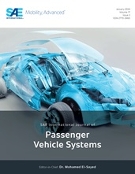Your Destination for Mobility Engineering Resources
Announcements for SAE Mobilus
Browse All1 of 2
2 of 2
3 of 2
Recent EDGE Research Reports
Browse All 1421 of 2
2 of 2
3 of 2
4 of 2
5 of 2
Latest Journal Issues
Browse All 161 of 3
2 of 3
3 of 3
4 of 3
5 of 3
Recent Books
Browse All 9361 of 2
2 of 2
3 of 2
4 of 2
5 of 2
Recently Published
Browse AllThe Aerospace Industry's drive towards zero defects has seen a significant shift to prevent defects and improve product quality during the design phase, instead of waiting until post-production inspection to discover and troubleshoot problems. Trying to ensure zero defects during the post-production inspection phase is too late in the product life cycle because it can lead to substantial costs. Aerospace Engine Supplier Quality (AESQ) introduced the Advanced Product Quality Planning (APQP) [2] process to realize zero defects. In APQP Phase 2 [2], Product and Design Development, a key output is performing a Design Failure Modes and Effects Analysis (DFMEA). Moog has effectively implemented a DFMEA process that adeptly identifies and mitigates design risks. This work showcases Moog's successful deployment of DFMEA, exemplifying the industry best practices. This work also presents simplified and innovative interpretations of DFMEA definitions and approaches. By addressing defects during
With regards to any aerospace mission, it is very useful to have awareness about the state of vehicle, i.e., the information about its position, velocity, attitude, rotational rates and other concerned data such as control surface deflections, landing gear touchdown, working of mechanisms and so on. The sensor data from the vehicle that is communicated to the ground can be difficult to perceive and analyze. A frame work for real-time motion simulation of an aerospace vehicle from onboard telemetry data is henceforth developed in order to improve the understanding about the current state of the mission and aid in real-time decision making if required. The telemetry data, that is transmitted through User Datagram Protocol (UDP), is received and decoded to usable format. The visualization software accepts the data in a fixed time interval and applies the required transformations in order to ensure one-to-one correspondence between actual vehicle and simulation. The transformations
The paper presents a theoretical framework for the detection and first-level preliminary identification of potential defects on aero-structure components by employing ultrasonic-guided wave-based structural health monitoring strategies, systems and tools. In particular, we focus our study on ground inspection using a laser-Doppler scan of the surface velocity field, which can also be partly reconstructed or monitored using point sensors and actuators structurally integrated. Using direct wavefield data, we first question the detectability of potential defects of unknown location, size, and detailed features. Defects could be manufacturing defects or variations, which may be acceptable from a design and qualification standpoint; however, those may cause significant background signal artefacts in differentiating structure progressive damage or sudden failure like impact-induced damage and fracture. We consider the surface velocity field over continuous time stamps obtained from laser
A Gerotor pump is a positive displacement pump consisting of inner and outer rotors, with the axis of inner rotor offset from axis of outer rotor. Both rotors rotate about their respective axes. The volume between the rotors changes dynamically, due to which suction and compression occurs. Due to their high-speed rotations, a Gerotor pump may be subjected to erosion due to cavitation. This paper details about the Computational Fluid Dynamics (CFD) based methodology that has been used to capture cavitation bubbles, which might form during the operation of Gerotor pump and to identify the erosion zone which might be occur due to cavitation bubble getting burst near the surface layers of the gears. A full scale (3D) transient CFD model of a Gerotor pump has been developed using commercial CFD code ANSYS FLUENT. The most challenging part of this CFD flow modeling is to create a dynamic volume mesh that perfectly represents the dynamically changing rotor fluid volume of the Gerotor pump
A structural load estimation methodology was developed for RLV-TD HEX-01 hypersonic experimental mission, the maiden winged body technology demonstrator vehicle of ISRO. Primarily the method evaluates time history of station loads considering effects of vehicle dynamics and structural flexibility. Station loads of critical structures are determined by superposition of quasi-static aerodynamic loads, dynamic inertia loads, control surface loads and propulsion loads based on actual physics of the system, improving upon statistical load combination approaches. The technique characterizes atmospheric regime of flight from vehicle loads perspective and ensures adequate structural margin considering atmospheric variations and system level perturbations. Features to estimate change in loads due to wind variability and atmospheric turbulence are incorporated into the load estimation methodology. Augmentation in loads due to structural flexibility is assessed along the trajectory using vehicle
In any human space flight program, safety of the crew is of utmost priority. In case of exigency in atmospheric flight, the crew is safely and quickly rescued from the launch vehicle using Crew Escape System (CES). CES is a critical part of the Human Space Flight which carries the crew module away from the ascending launch vehicle by firing its rocket motors (Pitch Motor (PM), Low altitude Escape Motor (LEM) and High altitude Escape Motor (HEM)). The structural loads experienced by the CES during the mission abort are severe as the propulsive, aerodynamic and inertial forces on the vehicle are significantly high. Since the mission abort can occur at anytime during the ascent phase of the launch vehicle, trajectory profiles are generated for abort at every one second interval of ascent flight period considering several combinations of dispersions on various propulsive parameters of abort motors and aero parameters. Depending on the time of abort, the ignition delay of PM, LEM and HEM


